
8 Email List Cleaning Best Practices for 2023 [+Services]
So you followed all the steps to build and nurture your list, but what happens when your engagement rates start declining, and you receive more soft and hard bounces than you expected? Well, in this case, it’s time for some email list cleaning!
Below, we are going to take a more detailed look at:
- The reasons you need to keep your lists clean
- Some best practices to make it happen
- A few tools to get started
Now let the email list purge begin!
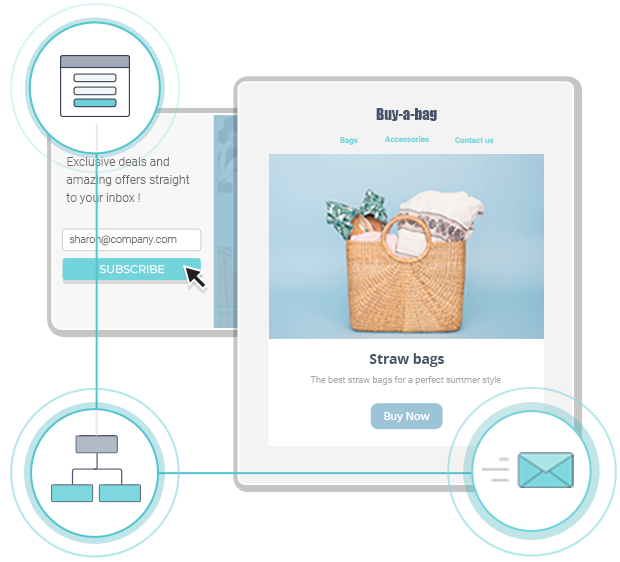
The easiest and most affordable email marketing and newsletter software!
What Is Email List Cleaning?
Email list cleaning – also called email scrubbing – is the process of removing outdated emails, spam accounts, and disengaged contacts from your lists to increase your engagement rates and return-on-investment.
Most email marketing services like Moosend or Mailchimp offer list cleaning tools, but there are also standalone solutions helping marketers to maintain clean lists and a high deliverability rate. You can find them below in a dedicated section.
Why Should I Clean My Email List?
Apart from ensuring a high engagement rate, maintaining a clean email list will also boost your inbox placement. This means that your audience will be able to receive your messages as you’ll have a high email deliverability rate.

But how do your email lists get “dirty” in the first place? Well, there are numerous reasons for that. The most common ones include human error, duplicate emails, invalid email addresses, spam accounts, inactive subscribers, and disposable emails.
By removing these “bad email addresses,” you will have a list of valid email addresses and engaged users that will help you achieve high conversion rates. Of course, your deliverability isn’t the only thing affected by unchecked email databases. Among other things, neglecting to perform regular email cleaning will eventually:
- Harm your email sender reputation, i.e., the score assigned to you by Internet Service Providers (ISPs)
- Result in multiple email bounces
- Increase your email marketing cost and impact your lead generation efforts negatively
- Lead to an increased number of spam complaints that will harm your deliverability
- Give you a high bounce rate and unsubscribes
Email scrubbing will help you avoid all of the above, improving your deliverability metric, open rates, and click-throughs. Also, if email providers like Gmail, Outlook, and Yahoo think that you’re spamming your audience, they will automatically send your messages to the spam folder.
So, if you notice low open and click-through rates, high bounces, and you receive multiple spam complaints, it’s time to perform an email list purge.
Below, you’ll find some of the best ways to nail email scrubbing in simple steps. Let’s see!
1. Plan your list-cleaning process
Let’s start with a question: How often do you need to clean your email list? If you thought once in a while, then you need to reconsider it. Cleaning your contact list is an ongoing process that requires time and effort. As your list grows, you need to perform frequent checks to ensure that it is free of bad email addresses.
But how frequently should you do it? Well, depending on your email list growth rate, performing an email scrub every two months is an excellent way to keep your contacts in order. Of course, you should always check your metrics (open rates, bounces) to determine whether you need to run an emergency email scrub or make it more frequent.
Planning your process is the best way to start. So here’s what you need to do to create an effective one:
- Set up a consistent list cleaning schedule
- Assign dedicated people to perform the task
- Have the tools and resources you need to do it
A successful email list cleaning process needs to rely on frequency and consistency. So to succeed, you first need to understand that this isn’t a single-time thing but an ongoing task.
Moreover, creating a list cleaning calendar is perfect for reminding you and your team when you need to reorganize your contacts. So make sure to craft one and incorporate it into your email marketing calendar!
2. Use double opt-in
Identifying and removing “bad email addresses” from your list can be a tedious task. But what if you can minimize the number of invalid or duplicate contacts right from the start?
Well, setting up a double opt-in process is the easiest way to nail email validation without using additional tools. All you have to do is to adopt the double opt-in method and prompt your new subscribers to confirm their email address as Merc Clothing does:
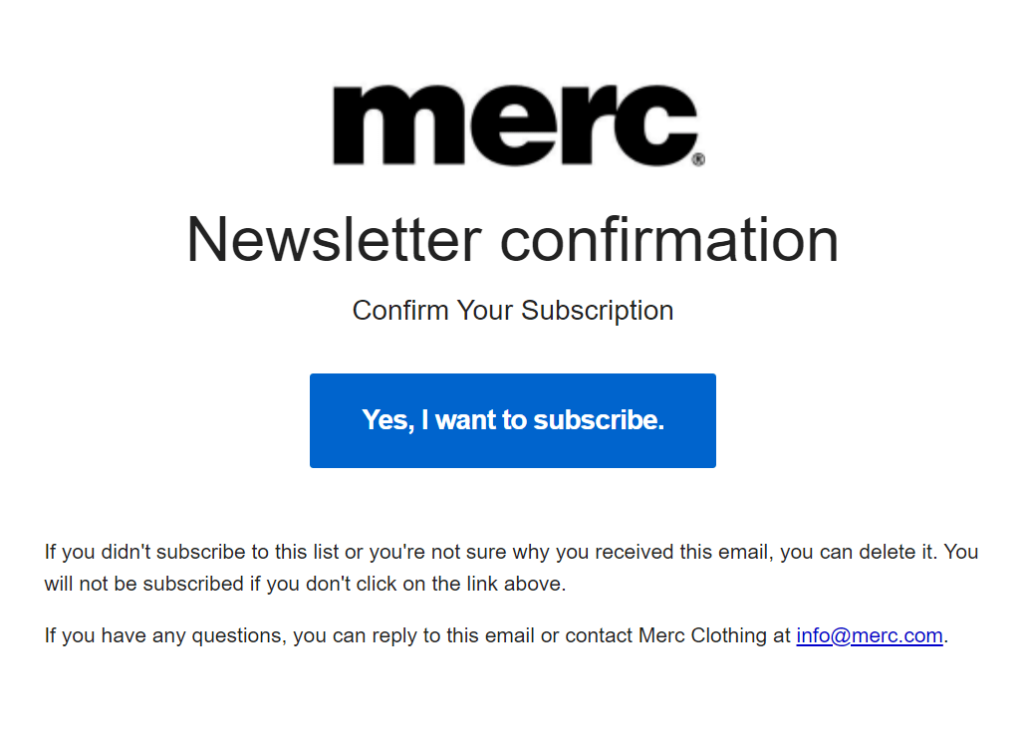
This extra step is necessary to avoid adding unconfirmed or spam email addresses to your contact list. Sadly, a large number of businesses aren’t using double opt-in, especially in the US, where the GDPR law isn’t in effect. While double opt-in adds an extra step to the process, you should use it to minimize the number of “bad emails” ending up in your list.
So adopting the email confirmation message is the first step to creating an effective list building process that will save you the trouble of removing duplicate and fake email addresses.
3. Set criteria for unengaged subscribers
Now the next question is how do you define a disengaged subscriber? Well, to do so, you need to set some criteria as to what “disengaged” means.
For instance, a recipient who interacts with 70% of your email marketing campaigns is interested enough to engage with you. On the other hand, someone who only opens 20% of your messages may show little to no interest in your business.
Establishing specific criteria to spot your low-engagement subscribers is the first step to performing a successful email list cleaning.
So when you find them, you can:
- Start removing duplicate email addresses from the list
- Clear out subscribers who marked you as spam to avoid having your deliverability harmed by spam filters
- Find and separate your soft from your hard bounces.
Identifying your disengaged audience accurately will help you perform more effective email scrubs. Also, the above process will allow you to filter your contacts, discover patterns and then create the perfect strategy to power up your email list hygiene.
4. Improve your segments
Segmenting your audience is one of the most crucial list building tactics to deliver targeted content. As you know, you can group your subscribers and customers based on different criteria, like their demographics, location, and so on.
However, did you know that you can also divide your audience based on their email activity? For example, you can group your non-openers and target them anew with specific messages to see whether they will interact with your campaigns or not.
Similarly, you can generate reports to discover which email addresses bounced. If they were hard bounces, then you need to remove them from your list without a second thought. However, if it’s a soft bounce, you can try sending those contacts another email in case their inbox was full, or the server was down.
Paying attention to your segments and reorganizing your contacts is essential to ace your email list management and boost your email metrics. So make sure to revisit them frequently to make sure that you deliver the right content to the right people!
5. Target your audience with re-engagement campaigns
Removing non-openers and disengaged users is the easiest thing to do. Nevertheless, if you want to build an effective list, you need to establish relationships with your audience.
As you know, the reasons for disengagement vary, with the lack of engaging content being the most common. Sometimes, your subscribers may also be experiencing “email fatigue,” so you can’t be sure why they didn’t open your recent campaigns.
The best way to get them interested in your business is to target them with smart re-engagement emails. Here’s an example by Levi’s:
Subject line: Just for you… because it’s been a while.
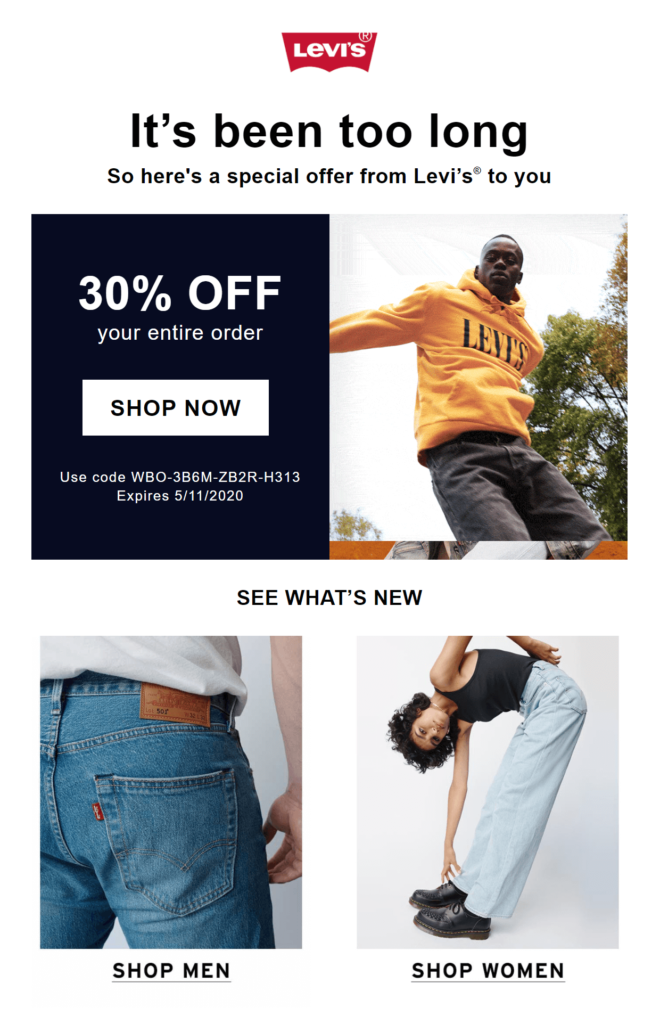
Your re-engagement campaigns need to have the right incentive to get your subscribers to act. For instance, you can deliver special discounts and exclusive deals like the above example or create unique content to nurture them anew.
Apart from giving them an irresistible offer, you can give your email subscribers the opportunity to choose the number of emails they want to receive from you or the type of messages they prefer. This way, you will improve your segments and the health of your list.
6. Use the unsubscribe button to your advantage
One of the most essential elements of a newsletter campaign is your unsubscribe button. This link, usually found in the email footer, allows your interested contacts to remove themselves from your list easily. Check out this example by Captions:
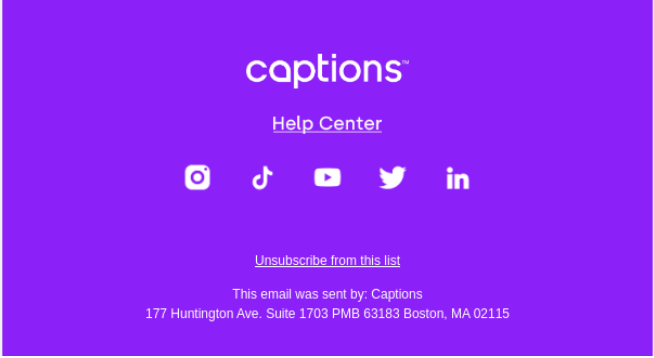
Making your unsubscribe buttons clear and visible will help you power up your list cleaning efforts and give your disengaged audience a quick way out. While most email marketers add unsubscribe links in the footer, you can also place them above the fold to make the process faster.
Giving your disengaged subscribers a way out is one of the simplest ways to keep your email list clean. Also, don’t forget that hiding the unsubscribe link will trigger spam complaints. So being transparent and letting your unengaged contacts go is more preferable to getting flagged as a spammer or ending up on a blacklist.
7. Keep your lists clean with marketing automation
Most email service providers (ESPs) out there will offer you marketing automation options to streamline your efforts. As a tool, creating automated workflows will help you target your audience with the right message at the right time.
For email list cleaning, you can leverage this feature to set up sequences based on specific rules and subscriber actions. For instance, crafting a workflow to remove bounced email addresses is perfect for automating your list cleaning process.
Similarly, you can choose various triggers/actions to keep your list up-to-date. For example, you can use marketing automation to improve your list by creating new segments with your non-openers or low engagement contacts. Moreover, having a lead scoring model in place is also a great way to discover your most active users and vice versa!
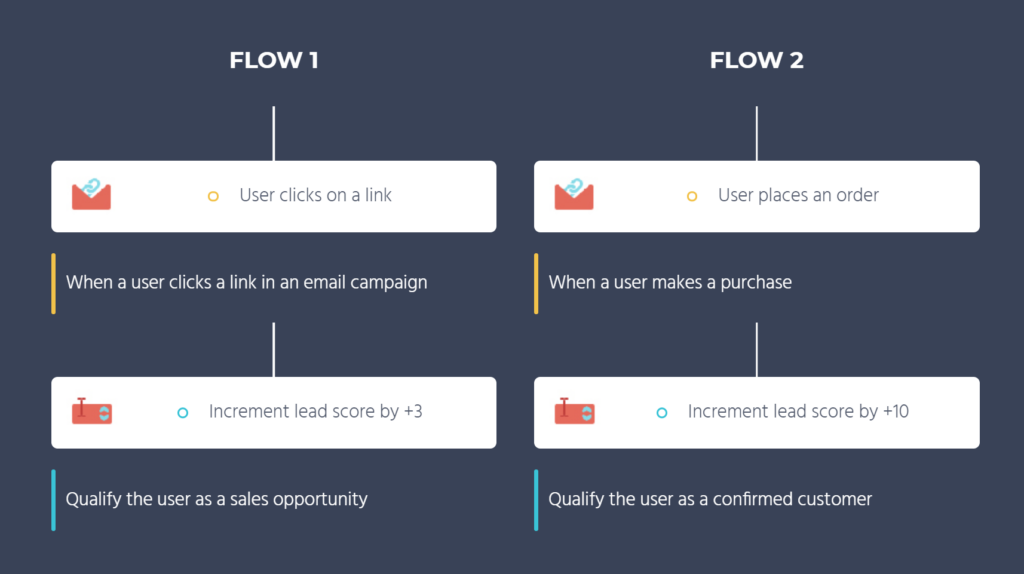
Now, to get started, you’re going to need a marketing automation software with advanced functionality to help you out. Email platforms like Moosend and Mailchimp already have the necessary tools to create automated sequences to keep your lists in order.
If you want to give it a try, sign up for a Moosend account and hop into the visual editor to see how it works!
8. Use a dedicated email list cleaning tool
All of the above steps focus on the actions you can take to clean your email list. But what if you need a helping hand?
Well, in this case, you can use a list cleaning tool to make the process easier, especially if you have neglected cleaning your list. Email validation services like EmailListVerify and Neverbounce have developed a set of tools to help you improve your deliverability, avoid spam traps, and keep your lists healthy and tidy.
In brief, most email scrubbing services offer:
- Real-time email verification
- Bulk email list verifiers
- Disposable email checkers
- Integrations with popular ESPs
Of course, using a dedicated email verification tool shouldn’t be seen as the “cure” of your list but as an ally to streamline the process. At the end of the day, an email list cleaning service is there to equip you with tools to do the job, not tell you the cause of your subscriber’s disengagement.
This, dear marketers, you have to discover yourselves and use the insights to improve your email marketing strategy as a whole.
6 Best Email List Cleaning Services To Get Started
Below, you’ll find some great options you can choose to power up your email list cleaning efforts. Let’s check them out!
1. EmailListVerify
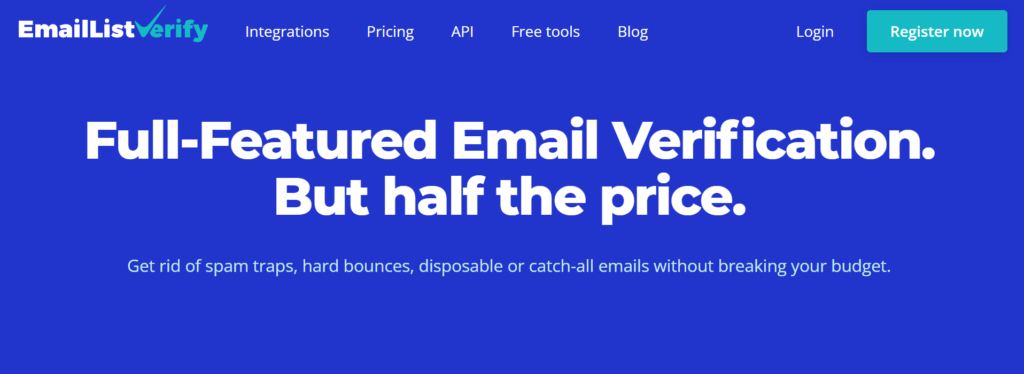
EmailListVerify is a full-fledged email verification service to help you detect spam traps, hard bounces, and improve the ROI of your email marketing campaigns. The platform offers an array of features, such as domain and SMTP validation to purge your list of invalid or inactive domains and remove incorrect email addresses.
On top of that, you have at your disposal a spam trap checker to improve your sender reputation score and a syntax error validator that notifies your website visitors in real-time through API. Among others, you can benefit from the disposable email cleaner and MX record validator to get rid of temporary email addresses and validate your email server records.
Pricing: EmailListVerify offers pay-as-you-go and monthly plans. The lowest tier starts at $139/month for 5,000 emails/day.
2. Neverbounce

Neverbounce is another email cleaning service you can use to analyze your mailing lists. More specifically, the platform offers three main features. With Clean, you can upload your lists to verify your contacts and have your list cleaned on the spot. Also, you can leverage the bulk email list cleaning option to improve your sender reputation and increase your inbox placement.
With Verify you can benefit from real-time email verification to target your subscribers when they join your list. This means that you can connect your lead gen pages, signup forms, or CRM with the tool to prevent “bad email addresses” from entering your list. Lastly, you can use Sync to automate your list cleaning by connecting Neverbounce with your email provider.
Pricing: You can try the tool for free or book a demo. Then, paid plans start at $10/month for up to 1,000 emails.
3. ZeroBounce
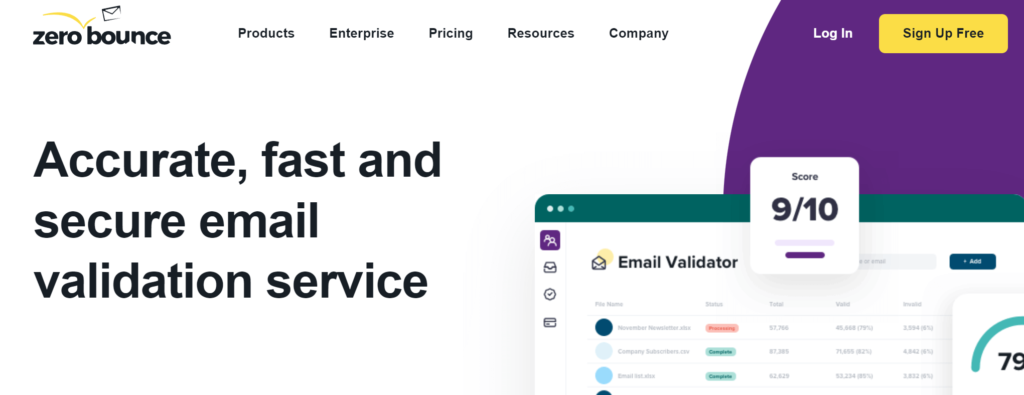
Zerobounce promises to help you improve your open rates and increase your efficiency with a fast and secure tool. The platform is equipped with a range of features to clean your email list and reach your audience. More specifically, you can use the email validator to detect bounces, spam traps, bots, and easily remove them from your list.
What’s more, Zerobounce sports an Activity Data tool to help you improve your email metrics and revenue. This addition will help you collect insights about your subscribers and improve your customer engagement long-term. Apart from email validation, the platform offers an email testing tool to check whether your messages will reach the inbox before pressing the send button.
Pricing: You can test the tool by signing up for the free plan for 100 validations/month. For more, paid plans start at $15/month for 2,000 emails.
4. QuickEmailVerification
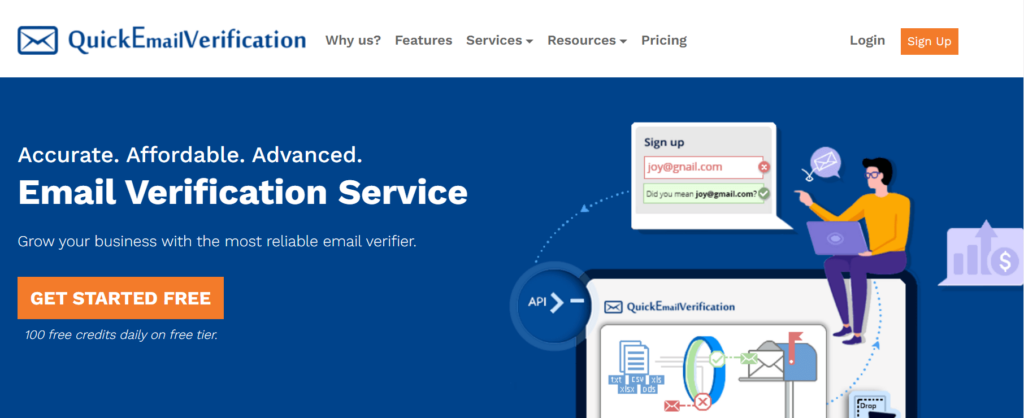
QuickEmailVerification is a simple software solution to power up your email scrubbing efforts. This email verifier offers bulk email validation tools for email marketers, as well as an email validation API for developers. Using the tool is very easy as it has a drag-and-drop function, allowing you to add your lists to your account and start the verification process.
What’s more, the service is perfect for enterprises as it is designed to process a large number of emails at once. Reporting is essential for your list cleaning, and QuickEmailVerficiation will let you generate reports with detailed metrics to optimize your list management.
Pricing: The email list cleaning service has a freemium plan for small businesses and startups. For premium features, you will need a paid plan starting at $25/month for 500 credits/day.
5. VerifyBee
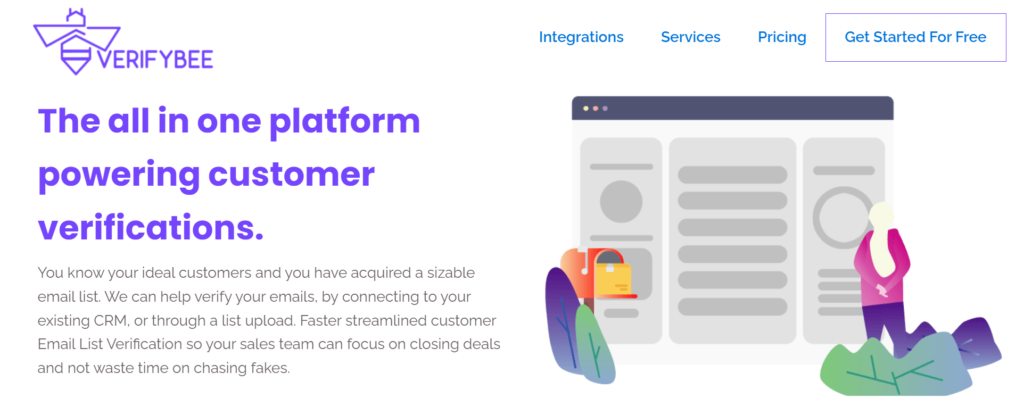
Last but not least, we have VerifyBee, an all-in-one platform to simplify email list verification. You can start the process instantly by copying and pasting your contacts. Then, the tool will find duplicate emails, typos, and syntax errors and perform an MX record check for better accuracy.
Apart from verifying your subscribers’ email addresses, you can integrate the software with your CRM and verify phone numbers. Overall, VerifyBee is a great tool to check your domain validity, CatchAll address, spam traps, as well as ping email servers for server validity.
Pricing: The software offers a free trial you can use to try it out. After that, you need to upgrade to a paid subscription, starting at $19/month for 2,500 verifications/month.
6. Email List Validation
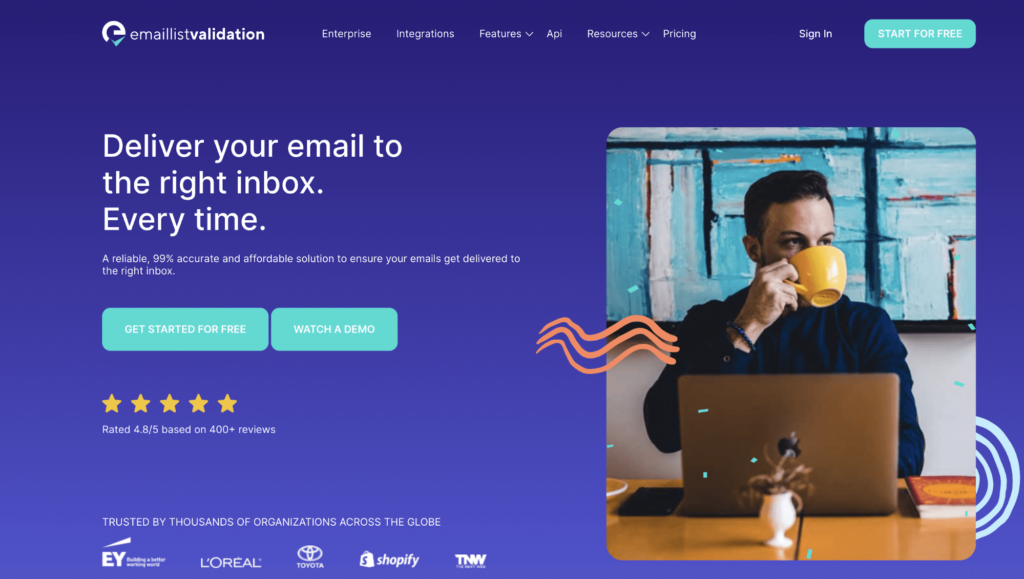
Email List Validation is a cutting-edge email list cleaning service that allows you to check your email list in bulk, detects invalid addresses, temporary emails, duplicate emails, and spam traps and also removes hard-bounced emails. Moreover, it verifies syntax errors in just minutes with a verification process.
The tool boasts a 99% accuracy, while it can process up to 5 million emails. Its functionality also includes domain validation. Finally, this software can be integrated with popular ESPs, CRMs and other marketing tools to make your life easier.
Pricing: The service gives you the option to get started for free. Paid plans start at $19/month for 2,500 emails, while the more verifications you buy, the less you pay per verification.
How To Clean Your Email List With Moosend
Cleaning your lists organically, i.e., without the help of external tools, is possible through marketing automation. As mentioned above, you can create workflows based on user engagement and actions to unsubscribe inactive contact automatically.
Below, we’ll see how you can easily leverage some simple tools to perform an efficient email scrub with Moosend. Let’s start!
Email list cleaning through segmentation
Moosend’s platform sports advanced segmentation and automation features to power up your sales and keep your audience engaged.
More specifically, you can create specific segments for your non-openers, as you can see in the example below:

This segment will allow you to find your disengaged subscribers by setting rules like “Opened Any Campaign.” Then, you can export your new “bad email list” and unsubscribe or re-engage your contacts.
What’s more, Moosend gives you the option to remove inactive contacts, archive list members, delete them or copy them from other lists through the Bulk Actions option.

Email scrubbing through marketing automation
Apart from cleaning your list through the audience management system, you can leverage Moosend’s advanced marketing automation capabilities to streamline the process.
For example, you can create custom sequences that will unsubscribe specific contacts based on their behavior. You can start your flow with the “When some people don’t open my campaigns” trigger:

After setting a specific timeframe, you can choose the action you want to perform; in this case, unsubscribing the disengaged subscribers from the email list you want to clean:
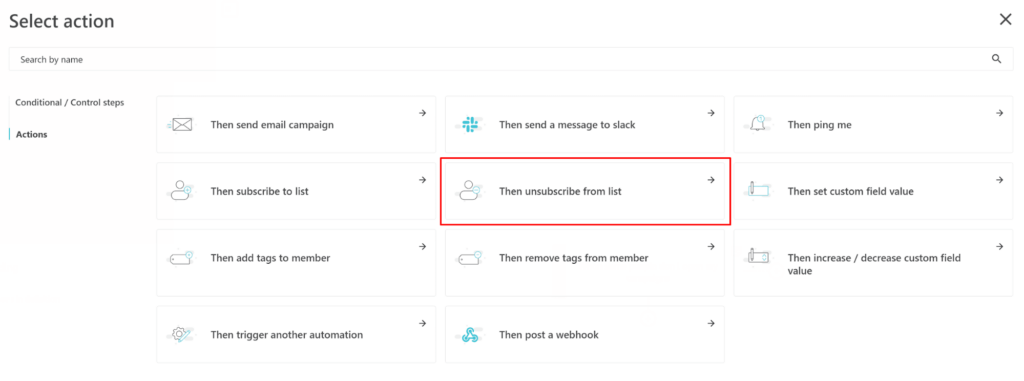
If you follow the above steps, your email list cleaning sequence will look like the example below. You can also choose more steps and actions based on your needs, but here’s the simple version:
All you have to do to access Moosend’s marketing automation tools is sign up for an account, import your mailing lists, hop into the visual workflow builder, and automate the list cleaning process like a pro!
What’s Next?
List cleaning isn’t a one-time thing. It needs to be performed regularly to keep your email list free of “bad email addresses.”
The easiest way to nail this time-consuming yet necessary process is to establish and follow a consistent email list cleaning schedule for maximal results. Then, you have to find your disengaged subscribers, improve your segments, and try to re-engage your audience.
You can do all of the above through your email marketing software. Moosend’s platform is equipped with the right tools to help you succeed, so if you feel it’s a match, make sure to sign up for an account and get started today!
FAQs
Want some quick answers to the most common questions regarding email list cleaning? We got you covered:
1. How do I keep my email list clean?
You can use an email verifier and follow tactics, such as building a double opt-in process, adding unsubscribe buttons on emails, and enhancing your segmentation and automation efforts.
2. How often should I clean my email lists?
You can conduct email list cleaning every two months or choose the best frequency based on email metrics, such as bounce rates and spam complaints.
3. What are the best practices for email list cleaning?
Best practices include: 1) A double opt-in process, 2) Unsubscribe buttons, 3) Better segmentation criteria, 4) Dedicated automation workflows, and 5) Email list cleaning services.
4. What are the best email list cleaning services?
Our top recommendations are: 1) EmailListVerify, 2) Neverbounce, 3) ZeroBounce, 4) QuickEmailVerification, 5) VerifyBee and. 6) Email List Validation.




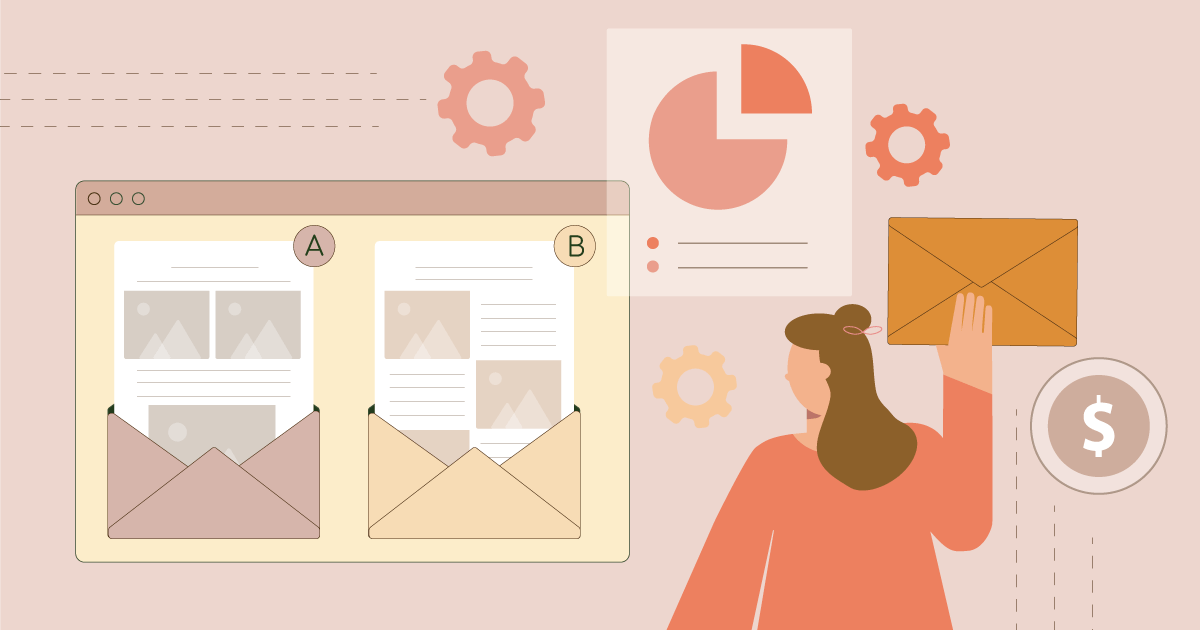
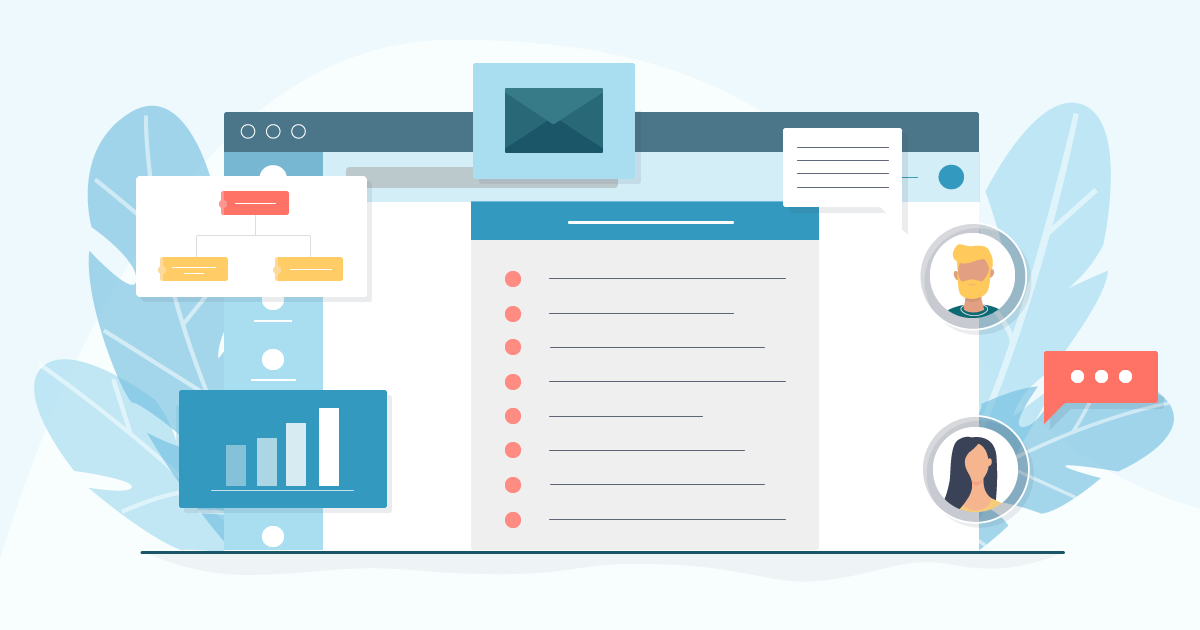
 Published by
Published by 